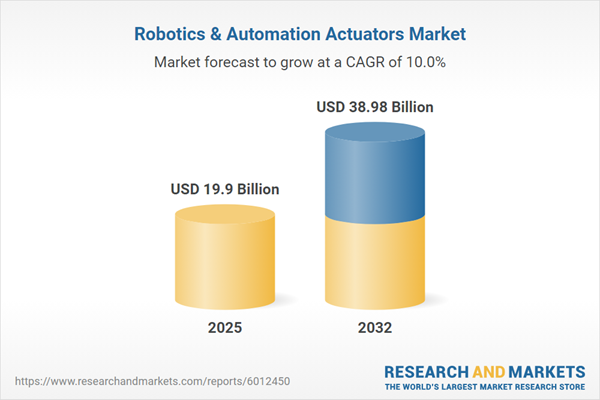Speak directly to the analyst to clarify any post sales queries you may have.
The Robotics & Automation Actuators Market is rapidly evolving as organizations seek smarter, more efficient motion control solutions across diverse industries. Senior decision-makers need precise insights to navigate shifting technology trends, global supply disruptions, and regulatory impacts while capturing opportunity in a dynamic sector.
Market Snapshot: Robotics & Automation Actuators Market Growth and Trends
The market grew from USD 18.14 billion in 2024 to USD 19.90 billion in 2025, and is forecasted to achieve a compound annual growth rate (CAGR) of 10.03%, reaching USD 38.98 billion by 2032. This trajectory highlights sustained demand for actuators as critical enablers of precision, speed, and adaptability in robotics and automated processes. Contributing factors include the integration of digital control, the rise of intelligent sensors, and a growing industrial focus on automation for enhanced efficiency.
Scope & Segmentation of the Robotics & Automation Actuators Market
The report examines the market from a multidimensional perspective, addressing product, end-user, and geographic variables. Key segmentation points include:
- Actuator Type: Electric, Hydraulic, Magnetic (Electromagnetic, Permanent Electric), Piezoelectric, Pneumatic
- Motion Type: Linear (Ball Screw, Belt & Pulley, Rack & Pinion), Rotary
- Actuation Method: Force Control, Position Control, Speed Control, Torque Control
- Sales Channel: Aftermarket, OEM
- Distribution Channel: Offline, Online
- End-User Industry: Aerospace & Defense (Flight Control, Landing Gear, Weapon Systems), Automotive (Chassis Control, Powertrain, Seating & Comfort), Consumer Electronics, Healthcare (Diagnostic Equipment, Patient Handling, Surgical Robots), Industrial Machinery (Material Handling, Packaging, Robotics)
- Region: Americas (United States, Canada, Mexico, Brazil, Argentina, Chile, Colombia, Peru), Europe, Middle East & Africa (United Kingdom, Germany, France, Russia, Italy, Spain, Netherlands, Sweden, Poland, Switzerland, United Arab Emirates, Saudi Arabia, Qatar, Turkey, Israel, South Africa, Nigeria, Egypt, Kenya), Asia-Pacific (China, India, Japan, Australia, South Korea, Indonesia, Thailand, Malaysia, Singapore, Taiwan)
- Companies Analyzed: ABB Ltd., Parker-Hannifin Corporation, Actuonix Motion Devices, Bray International Inc., Carotek (SunSource Fluid Process Group), Columbus McKinnon Corporation, Creative Motion Control, Curtiss-Wright Corporation, DVG Automation Spa, Emerson Electric Co., Ewellix (Schaeffler AG), Festo Corporation, Firgelli Automations Inc., John Henry Foster, LINAK A/S, Macron Dynamics Inc., MISUMI Corporation, Mitsubishi Electric Corporation, Moog Inc., NOOK Industries, Ramén Valves AB, Regal Rexnord Corporation, Rockwell Automation Inc., Rotomation Inc., Rozum Robotics LLC, Siemens AG, SMC Corporation, Synapticon GmbH, Thomson Industries Inc., Toyo Robotics, Valmet Corporation, Yaskawa Electric Corporation
Key Takeaways for Senior Decision-Makers
- Technological advances transform actuators from basic mechanical components into intelligent, adaptive devices integral to robotics and automation strategies.
- Industry-wide shifts toward sustainable manufacturing emphasize recyclable actuator materials, energy-efficient designs, and recovery mechanisms to align with global environmental objectives.
- Rising adoption of collaborative robots requires actuators designed for seamless human-machine interaction, ensuring operational safety and rapid production line changeover.
- AI integration and edge computing are enabling predictive maintenance and on-the-fly calibration, driving up-time and reducing lifecycle costs.
- Materials constraints, safety-focused regulatory pressures, and supply chain instability demand risk mitigation through regional sourcing and modular design principles.
Tariff Impact: Navigating New US Policy Shifts
Newly introduced US tariffs on actuator components in 2025 are significantly altering procurement and supply chain flows. Increased duties are driving manufacturers to reassess sourcing strategies, regionalize production, and manage costs by seeking supplier diversity and investing in flexible, modular actuator platforms. Carefully structured partnerships and adoption of digital procurement platforms are increasingly crucial for cost control and supply continuity.
Methodology & Data Sources
This analysis combines primary interviews with C-level executives and technical experts, supplemented by comprehensive reviews of regulatory filings, industry publications, and technical white papers. Advanced data models, SWOT analysis, and peer-reviewed processes ensure reliability and robust insight across qualitative and quantitative parameters.
Why This Report Matters
- Equips stakeholders with data-driven insights on competitive dynamics, emerging technologies, and regulatory landscapes in the robotics & automation actuators market.
- Uncovers actionable opportunities for supply chain resilience, technology investment, and sustainability in actuator deployments across key sectors.
Conclusion
The evolution of actuator technologies is redefining robotics and automation strategies. Organizations that prioritize adaptability, digital integration, and sustainable innovation will lead the transformation of industry operations.
Additional Product Information:
- Purchase of this report includes 1 year online access with quarterly updates.
- This report can be updated on request. Please contact our Customer Experience team using the Ask a Question widget on our website.
Table of Contents
3. Executive Summary
4. Market Overview
7. Cumulative Impact of Artificial Intelligence 2025
Companies Mentioned
The companies profiled in this Robotics & Automation Actuators market report include:- ABB Ltd.
- Parker-Hannifin Corporation
- Actuonix Motion Devices
- Bray International Inc.
- Carotek, Inc. by SunSource Fluid Process Group
- Columbus McKinnon Corporation
- Creative Motion Control
- Curtiss-Wright Corporation
- DVG Automation Spa
- Emerson Electric Co.
- Ewellix by Schaeffler AG
- Festo Corporation
- Firgelli Automations Inc.
- John Henry Foster
- LINAK A/S
- Macron Dynamics Inc.
- MISUMI Corporation
- Mitsubishi Electric Corporation
- Moog Inc.
- NOOK Industries, Inc.
- Ramén Valves AB
- Regal Rexnord Corporation
- Rockwell Automation Inc.
- Rotomation, Inc.
- Rozum Robotics LLC
- Siemens AG
- SMC Corporation
- Synapticon GmbH
- Thomson Industries, Inc.
- Toyo Robotics
- Valmet Corporation
- Yaskawa Electric Corporation
Table Information
| Report Attribute | Details |
|---|---|
| No. of Pages | 196 |
| Published | November 2025 |
| Forecast Period | 2025 - 2032 |
| Estimated Market Value ( USD | $ 19.9 Billion |
| Forecasted Market Value ( USD | $ 38.98 Billion |
| Compound Annual Growth Rate | 10.0% |
| Regions Covered | Global |
| No. of Companies Mentioned | 33 |









